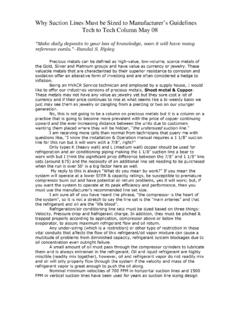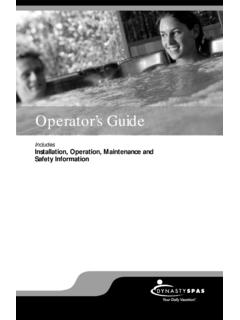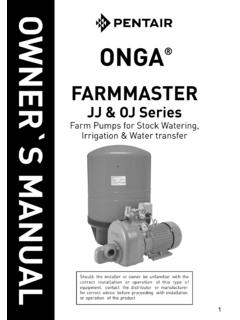Transcription of The Essentials Of Working With 410A
1 The Essentials Of Working With R-410A. Several major manufacturers are producing comfort air conditioning equipment using refrigerant 410A. The trend towards the use of 410A continues to grow and there is a demand for technicians who are comfortable Working with this higher-pressure replacement for refrigerant 22. Due to the differences between refrigerant 22 and the newer 410A, there is a concern within the industry regarding what those differences are as well as the additional training required to safely work on 410A systems. In an effort to properly educate installation and service technicians on the safe use, proper installation and servicing of 410A systems, several industry organizations, backed by numerous manufacturers created the AC & R Safety Coalition . This coalition produced a safety & training booklet and with the aid of ESCO Institute created a voluntary R-410a technician certification test. Although the 410A safety & training certification is not mandated by any government agency there is a movement to certify as many installers and technicians as possible in an effort to improve the understanding and safe handling of this higher pressure refrigerant.
2 Some manufacturers, contractors and industry organizations seem to be almost . requiring those who do business with them or work for them to become certified in the safe and proper use of R-410A. Although this particular certification is voluntary, failure to certify may cost contractors and technicians some lost business. The purpose of this article is to provide a brief overview of the Essentials of Working with R-410a. Those who have the time and opportunity to attend a R-410a certification seminar are encouraged to do so. Most of the seminars and published materials on this topic not only cover the specific differences necessary to the safe and proper handling of 410a, but they also review information that technicians should already know anyway. In this article only the essential differences between R-22 usage and R-410A usage will be discussed. However, if a technician is going to take the voluntary 410A safety exam he or she will be required to answer a number of general questions common to the function, operation and servicing of all mechanical compression cooling systems.
3 Every technician is expected to have a good solid knowledge of the complete mechanical cycle, superheat, subcooling, latent heats and the major components of a system. A review of the basic system, accessories and even global warming and ozone depletion is essential. Why 410A? Refrigerant 410A was developed to replace refrigerant 22 because R-22 is being phased out due to its ozone depletion potential. R-410A has no ozone depletion potential but does have a higher global warming potential. However, according to experts, the overall global warming potential with R-410A should decrease because of its higher efficiency reducing power plant emissions. The Essentials Of R-410A. System Pressures Technicians with R-22 experience will need to become familiar with Working with high and low side pressures that are much higher when using R-410A. A typical R-22. system operating normally with a head pressure of 260 psig at a 120-degree condensing temperature and a low side pressure of 76 psig at a 45-degree evaporator saturation temperature will find the equivalent pressures in a R-410A system to be much higher.
4 A normally operating R-410A system with the same condensing temperature of 120. degrees and a 45 degree evaporator saturation temperature will have a high side pressure of 418 psig and a low side pressure of 130 psig. Although refrigerant 410A is a near-azeotrope and has a slight temperature glide, there is no need to correct for refrigerant dew point and bubble point differences. Superheat and subcooling calculations can be calculated the same way we have always done with R-22 refrigerant. The only difference will be the higher pressure- temperature relationship when reading the temperature-pressure chart. The temperature glide for R-410A is only .3 degrees Fahrenheit and can be ignored and fractionation is not a concern. Compression Ratio & System Efficiency At first glance, one might ask the question, with 410A operating at higher pressures are the compression ratio higher and the efficiency less? The answer is no, the compression ratio is about the same or slightly lower than that of R-22 and the efficiency is higher.
5 Compression ratio is the absolute high side pressure divided by the absolute low side pressure. The compression ratio is affected by the pressure differential between the high and low sides of the system not how high both pressures are. Using the previous examples comparing the operating pressures of an R-22. system to an R-410A system, the R-22 system would have a compression ratio of :1, while the R-410A system would have a compression ratio of :1. The actual efficiency gains from R-410A are due to its superior thermodynamic values over R-22. Under identical operating conditions the discharge temperature on a 410A. system may actually be lower than on an R-22 system. With all else being equal, it is possible to manufacture an R-410A air conditioning system that is physically smaller using less refrigerant and a smaller compressor than an R-22 system of the same capacity and SEER rating. Compressors Compressors used on 410A systems use thicker metals to withstand the higher operating pressures.
6 Therefore, only a compressor designed for 410A should be used with 410A. The ideal compressor type for use with 410A is a scroll built to withstand the higher pressures. The scroll compressor has the advantage over the reciprocating compressor when comparing volumetric efficiencies and internal heat transfer losses between the suction and discharge ports. Scroll compressors compress the refrigerant in stages through the use of up to six individual pockets in its scroll assembly while reciprocating compressors raise the pressure from the suction pressure to the high side pressure in a single stroke. In addition, the scroll compressor's suction and discharge openings are farther apart than those in a reciprocating compressor thus decreasing heat transfer losses between the suction and discharge ports. The internal pressure relief valves inside the compressor opens at a pressure between 550 & 625 psig on compressors designed for R-410A service. Compressors designed for R-22 service have internal pressure relief valve settings that open between 375 & 450 psig.
7 So only compressors rated to work with R-22 should be used with R-22. and those rated for use with R-410A used with R-410A. Metering Devices The metering device used in a 410A system must be about 15% smaller in capacity as opposed to a metering device used in a R-22 system of the same capacity. It is imperative that only a metering device designed and properly sized for R-410A be used on a R-410A system. In fact, no parts designed for R-22 use should be used on a 410A. system. Refrigerant Lines Refrigerant lines used for R-410A must be properly sized for R-410A systems. It is possible to use existing refrigerant lines from an R-22 system in a R-410A system installation if they are of the correct size however, they must be cleaned of all debris and oil. The best practice is to replace the lines with new copper liquid and suction lines to ensure they are clean and do not have any weak areas that could be a problem at the higher operating pressures of 410A. Driers & System Accessories The desiccants used in R-410A systems are the same as those used for most other refrigerants.
8 Zeolites, molecular sieve type desiccants work on the principle of a material with small pockets or areas that adsorb moisture by the process of capillary action. This type of desiccant seems to work well with all modern refrigerants including R-410A. The metal shell containing the filter-drier however, must be thicker to withstand the higher pressures of 410A. Therefore, only use filter-driers rated for use on R-410A. R-410A filter-driers are those rated for pressures no less than 600 psig. When removing a filter-drier from a system it should be cut out with a tubing cutter not a torch flame. The desiccant in a filter drier adsorbs and holds moisture better when it is cool or cold. Therefore, if the desiccant is heated moisture may be driven out of the desiccant and into the system creating a moisture problem. This is of greater concern on R-410A systems because the oil used (POE) is highly hygroscopic. Once moisture is absorbed in a POE oil it is difficult to remove. Usually an oil change is necessary.
9 The practice of replacing the filter-drier every time the system is opened is particularly important on R-410A systems because of the hygroscopic nature of the oil used. Pressure Control Settings Because of the higher operating pressures, the high & low-pressure control settings must be higher than those encountered on R-22 systems. The recommended high- pressure control settings are a cut-out pressure of 610 psig and a cut-in pressure of approximately 500 psig. The recommended low-pressure control setting is a cut-out pressure of 50 psig. Make sure the pressure control you are using on a 410A system has the correct pressure range allowing it to be adjusted for the correct pressures. Oil R-410A systems use a synthetic Poly Ester (POE) oil. This oil has superior lubricating ability over the mineral oils commonly used in R-22 systems. Only POE oil should be used in a 410A system. However, not all POE oils are the same. There is a variety of POE oil types and grades therefore, it is important to know which POE oil is in the system being serviced.
10 Mixing some POE oils may create a compatibility problem and lead to a system failure. All POE oils are highly hygroscopic. That is, they absorb moisture quickly and hold the moisture they absorb. Once absorbed, the moisture cannot be removed through system evacuation even at vacuum pressures of 500 microns. Therefore, it is important to prevent moisture from getting in the oil in the first place. The general recommendations for handling POE oil is to keep it in a metal container, transfer it with an oil pump and keep the container sealed except when absolutely necessary. POE. oils are also irritating to the skin and a real medical concern if it comes in contact with your eyes. Gloves and safety glasses are essential items when Working with this oil. Brazed Connections The higher operating pressures encountered with R-410A systems requires the use of brazing materials rated to withstand these pressures. Some technicians have used lower temperature solders when making tubing connections on R-22 systems.




